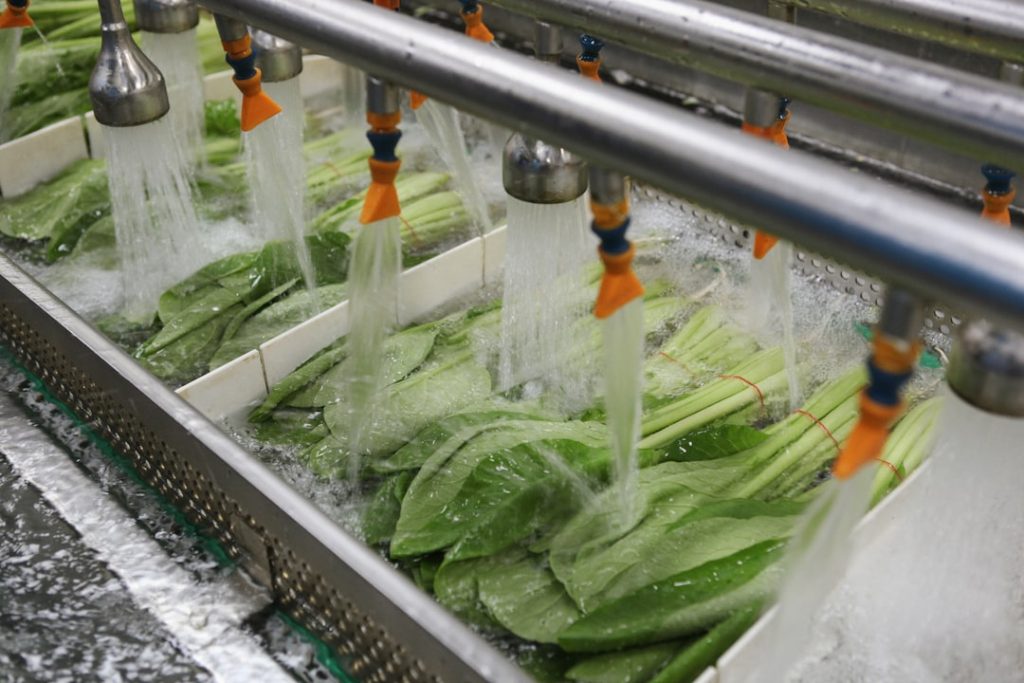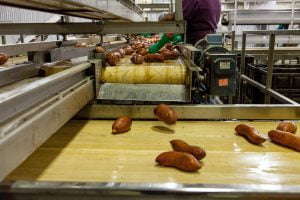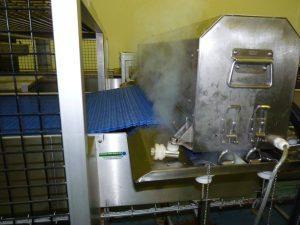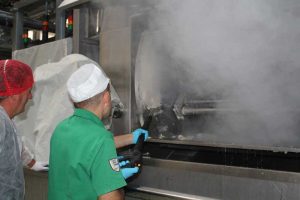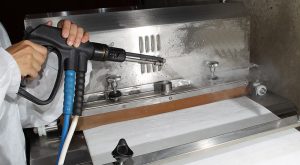Conveyor washing systems are an essential component in numerous industries, offering a cost-effective and efficient method for cleaning and sanitising products as they progress along a production line. These systems are engineered to eliminate contaminants, soil, and debris from various items, including food products, automotive components, and pharmaceuticals. Through the utilisation of water, detergents, and other cleaning agents, conveyor washing systems ensure that products meet stringent hygiene and safety standards prior to packaging and distribution to consumers.
Conveyor washing systems are available in a range of configurations, from basic spray bars to sophisticated multi-stage systems. They can be tailored to suit the specific requirements of different industries, rendering them a versatile solution for businesses seeking to enhance their production processes. With the capability to clean a wide array of products, conveyor washing systems fulfil a crucial role in maintaining high standards of cleanliness and quality control within manufacturing facilities.
Summary
- Conveyor washing systems are designed to clean and sanitise various types of products and materials as they move along a conveyor belt.
- There are different types of conveyor washing systems available, including spray washers, immersion washers, and rotary drum washers, each with its own unique cleaning method.
- The benefits of conveyor washing systems include improved cleanliness, reduced labour costs, and increased production efficiency.
- When choosing a conveyor washing system, it’s important to consider factors such as the type of material being cleaned, the required level of cleanliness, and the available space for installation.
- Regular maintenance and adherence to safety guidelines are crucial for ensuring the efficient and safe operation of conveyor washing systems.
Types of Conveyor Washing Systems
Spray Bar Systems
One common type is the spray bar system, which utilises high-pressure water jets to clean products as they move along the conveyor belt. This system is ideal for removing surface contaminants and can be customised with different nozzle configurations to suit specific cleaning requirements.
Immersion Systems
Another popular option is the immersion system, which involves submerging products in a tank of cleaning solution to remove dirt and debris. This method is particularly effective for cleaning small parts and components that may be difficult to reach with traditional spray systems.
Multi-Stage Conveyor Washing Systems
Additionally, there are also multi-stage conveyor washing systems that combine different cleaning methods, such as pre-washing, rinsing, and drying, to ensure thorough and effective cleaning of products.
Benefits of Conveyor Washing Systems

Conveyor washing systems offer a range of benefits for businesses across various industries. Firstly, they help to improve product quality by ensuring that items are free from contaminants and debris before they are packaged and distributed. This can lead to higher customer satisfaction and reduced product returns, ultimately saving businesses time and money.
Additionally, conveyor washing systems can help to increase production efficiency by automating the cleaning process. By integrating these systems into production lines, businesses can reduce the need for manual cleaning and free up valuable time for other tasks. This can lead to higher throughput and improved overall productivity.
Furthermore, conveyor washing systems also contribute to improved workplace safety by reducing the risk of accidents and injuries associated with manual cleaning processes. By automating the cleaning process, businesses can create a safer working environment for their employees, ultimately reducing the likelihood of workplace incidents.
Considerations for Choosing a Conveyor Washing System
When choosing a conveyor washing system, there are several important considerations to keep in mind. Firstly, businesses should consider the specific cleaning requirements of their products and choose a system that can effectively remove contaminants and debris without causing damage. Additionally, it’s important to consider the size and throughput of the production line to ensure that the chosen system can handle the required capacity.
Businesses should also consider the space available for installation and operation of the conveyor washing system. Some systems may require additional space for tanks, pumps, and other equipment, so it’s important to assess the available space and ensure that the chosen system can be easily integrated into the existing production line. Furthermore, it’s important to consider the cost of installation and operation when choosing a conveyor washing system.
Businesses should weigh the initial investment against the long-term benefits of improved product quality, increased efficiency, and reduced maintenance costs to determine the overall value of the system.
Maintenance and Safety Tips for Conveyor Washing Systems
Proper maintenance and safety practices are essential for ensuring the effective operation of conveyor washing systems. Regular maintenance, including cleaning filters, checking for leaks, and lubricating moving parts, can help to prevent breakdowns and prolong the lifespan of the system. Additionally, businesses should ensure that all employees operating or working near the conveyor washing system are properly trained in safety procedures to prevent accidents and injuries.
It’s also important to regularly inspect the system for any signs of wear or damage and address any issues promptly to prevent further problems. By staying proactive with maintenance and safety practices, businesses can ensure that their conveyor washing system continues to operate effectively and safely.
Case Studies of Successful Conveyor Washing Systems

Enhancing Food Safety and Quality
A food processing plant, for instance, implemented a multi-stage conveyor washing system to clean fruits and vegetables prior to packaging. This system helped to remove dirt and contaminants from the produce, leading to improved product quality and reduced waste.
Streamlining Automotive Manufacturing
In another case, an automotive manufacturing plant installed an immersion conveyor washing system to clean small parts before assembly. This system helped to improve production efficiency by automating the cleaning process and ensuring that parts were free from contaminants before being used in assembly.
Boosting Productivity and Efficiency
The implementation of conveyor washing systems has proven to be a valuable investment for these businesses, resulting in improved product quality, reduced waste, and increased productivity. By automating the cleaning process, companies can redirect resources to other areas of their operations, leading to further improvements and growth.
The Future of Conveyor Washing Systems
Conveyor washing systems play a crucial role in maintaining cleanliness and quality control in various industries. As technology continues to advance, we can expect to see further innovations in conveyor washing systems, such as improved automation, energy efficiency, and water conservation. With their ability to improve product quality, increase production efficiency, and enhance workplace safety, conveyor washing systems will continue to be an essential part of modern manufacturing processes.
Businesses that invest in these systems can expect to see long-term benefits in terms of improved product quality, increased efficiency, and reduced maintenance costs.
FAQs
What are conveyor washing systems?
Conveyor washing systems are automated systems used to clean and sanitise items as they move along a conveyor belt. These systems are commonly used in industries such as food processing, automotive manufacturing, and pharmaceuticals.
How do conveyor washing systems work?
Conveyor washing systems typically use a combination of water, detergents, and high-pressure jets to clean items as they pass through the system on a conveyor belt. The system may also include brushes, air knives, and drying tunnels to ensure thorough cleaning and drying.
What are the benefits of using conveyor washing systems?
Conveyor washing systems offer several benefits, including increased efficiency, improved cleanliness and hygiene, reduced labour costs, and the ability to handle a high volume of items in a short amount of time. These systems also help to ensure consistent cleaning results.
What types of items can be cleaned using conveyor washing systems?
Conveyor washing systems can be used to clean a wide range of items, including food products, automotive parts, containers, packaging, and various industrial components. These systems are versatile and can be customised to suit the specific cleaning needs of different industries.
What factors should be considered when choosing a conveyor washing system?
When choosing a conveyor washing system, factors to consider include the type and size of items to be cleaned, the required level of cleanliness, the available space for installation, the desired throughput capacity, and any specific industry regulations or standards that need to be met.


